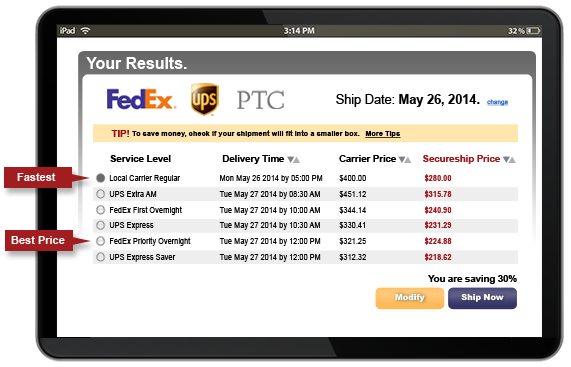
Nov 07, 2025 • by Paul Bourque
How much is shipping to Italy from Canada?
Shipping to Italy can be incredibly expensive, especially for next day service, but shipping broker Secureship finds its clients savings of 50% or more


by Dan Allard
Sep 18, 2017
Key Points
Table of Contents

Unless you ship hundreds of packages a day, you probably fall under the “small business shipper” category. You may sell items on eBay or Etsy out of your home or you may own a small brick-and-mortar business.
No matter the type of business you own, if you are shipping several packages every week there are actions you can take to reduce your shipping costs and save yourself time. In this guide we’ll cover how you can get the best shipping rates for your small business and how to implement best practices to streamline your process.
We’ll mostly cover internal shipping processes; however, it’s important to mention that the way you charge for shipping on the front-end will make a big difference in profitability. The challenge we face is determining a shipping solution that will affect your margins as little as possible, yet remain attractive to your customers.
This is something you’ll want to spend some time on. Studies have shown that the number one factor driving shopping cart abandonment is shipping and handling fees. There are many ways you can charge for shipping, here are the three most popular options:
Offering free domestic shipping can be very attractive to your customers, however, it can take a big cut out of your margins. The marketing advantages by displaying “Free Shipping” on your website can usually make up for the decreased margins in additional sales volume. However, this is something you’ll want to test for yourself, as every store and target customer base is different.
Instead of offering free shipping on all purchases many online retailers set a minimum purchase order to qualify for free shipping. This will help drive up your average order size and when customers only purchase a small ticket item you won’t have to consider the order a loss.
Many shopping cart platforms are now offering built-in shipping calculators that allow customers to receive shipping rates based on their location, order size, etc. Of course, there will be discrepancies, but in most cases, you can break even by charging your customers the real-time rate provided by the carrier you choose.
Depending on how you set it up, the shipping rate quoted can be the base price of the service offered by the carrier. When you purchase the postage on the back-end you can receive your business discount or search for other cheap shipping options to make a profit which could cover your packaging materials and labor.
The third option is to offer a flat rate for every package you ship, or flat rates for weight ranges or purchase totals. This method requires a lot of preparation and calculation to determine your average shipping cost, however, this is a best-practice you should be doing no matter the shipping strategy you choose.
Once you determine your average shipping cost, you can round it up to a number that will be attractive to your customers. Many online retailers offer $4.99 shipping, for example.
After you determine how you will charge your customers for shipping, it’s time to look for ways to reduce shipping costs for your small business. Here are seven factors that will affect the cost for each individual shipment you send:
How fast do your customers want to receive their items? With options like same-day, overnight, two-day, priority post, and more, it can be difficult to determine the best option. On one hand you want to reduce shipping costs, and on the other hand choosing the longest duration can lead to unhappy customers that potentially won’t come back.
We recommend testing out different delivery speeds to find the most inexpensive one that still leads to positive customer reviews.
The greater the distance the more shipping will cost. International shipping costs much more than domestic shipping and your shopping cart software should automatically calculate different shipping rates. There are also taxes and tariffs to consider depending on the destination country.
Lighter items are cheaper to ship than heavier items. Weight is a large factor in determining the shipping cost, so if you will be shipping heavier items we recommend getting price comparisons from multiple carriers to find the best option for you.
Smaller packages are easier and less expensive to ship than larger ones. It’s important to find the smallest package size for your item that will provide enough space for bubble wrap, packaging peanuts, or other protective materials.
When you ship enough packages you’ll understand that no matter the carrier you choose, there will be times when your packages will get lost, stolen, or damaged during transit. Consider the price of insurance compared to the cost of not purchasing insurance and the package potentially becoming lost.
Most online retailers allow their customers to track their packages in real-time. This is something you should consider in order to be competitive in your marketplace. Tracking features will usually add to your shipping rates.
If you are shipping fragile items you will want to pay additional fees to make sure your packages are handled with care. This will increase your shipping costs but reduce the amount of damage claims you receive.
Years ago shipping discounts were only available to large companies that shipped hundreds of packages per day. Today shipping discounts are offered to small businesses too, and there’s a good chance your business will qualify for discounts not available to consumers.
If you’ve shipped out enough packages you’ve probably realized that while one carrier may be the cheapest option for one shipment, they may not be the cheapest option for the next. Getting shipping quotes from multiple carriers used to take a long time, having to visit multiple websites or making multiple phone calls. However, there is now an easier solution.

With our service, you can get real-time quotes from multiple carrier companies and see who has the best prices, quickest delivery options, and how every company compares for your shipment. You also benefit by having one centralized place for all your shipments – history, tracking, scheduling pickups, and even your address books (who wants to try and maintain an address book with several carriers?).
See how much you can save on shipping by getting a free shipping estimate!

Nov 07, 2025 • by Paul Bourque
How much is shipping to Italy from Canada?
Shipping to Italy can be incredibly expensive, especially for next day service, but shipping broker Secureship finds its clients savings of 50% or more

Nov 03, 2025 • by Paul Bourque
What is the cheapest way to ship a package from Canada to Mexico?
Reducing a parcel's size and slowing its delivery are two easy ways to make a shipment to Mexico cheaper

Oct 27, 2025 • by Paul Bourque
Can I ship to France with FedEx?
FedEx's collection of airplanes and worldwide connections ensures regular package deliveries from Canada to France